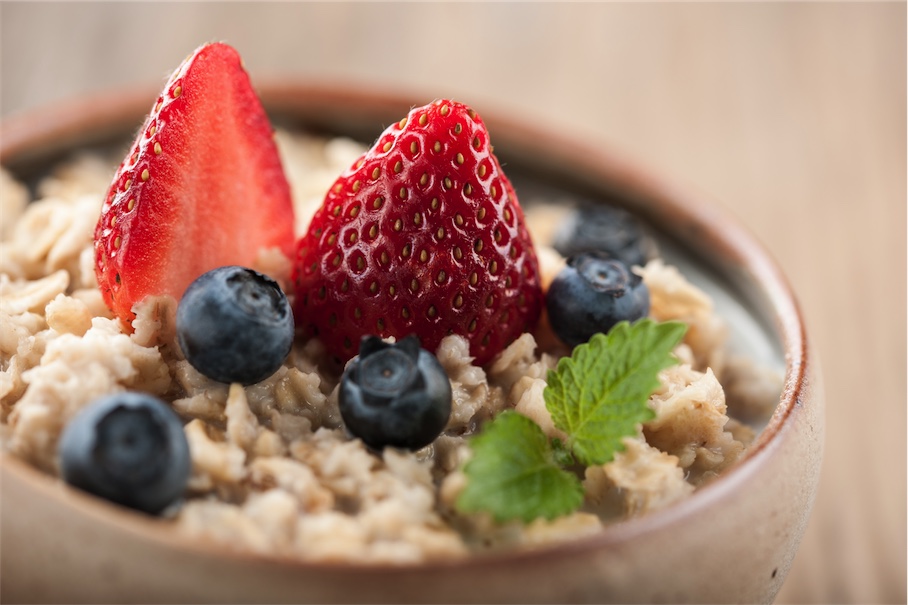Porridge makes a regular appearance on the breakfast menu at my house at during winter because it’s quick to prepare (with a little bit of work the night before), warming and keeps me satisfied right up until lunch. While oats are considered the “traditional” porridge grain other grains/seeds that are also used include barely, wheat, corn, buckwheat, quinoa and rice.
Amaranth Oat and Berry Porridge
Ingredients:
(1 serve)
• 1/3 cup rolled oats
• 2 tbsps amaranth
• 2/3 cup of water
• Pinch of sea salt
• 1 tspn ground cinnamon
• ½ cup of berries of your choice
• 1-2 tbsps ground linseed (flaxseed)
• 1 handful of roughly chopped nuts (walnuts, pecans, macadamia)
• Drizzle of maple syrup or raw honey
• 2 tablespoons of full fat natural yoghurt/coconut yoghurt
Method:
The night before place oats, amaranth, salt and water in a saucepan (covered) to soak and soften.
Add cinnamon to oat/amaranth mixture and stir to combine. You may need to add a little extra water so the mixture won’t be too “gluggy”. Cook the porridge for 3-4 minutes, stirring regularly, over a low-medium heat until slightly thickened.
Place in bowl and add linseed, berries, chopped nuts yogurt and a drizzle of maple syrup or honey.
Sit down and eat slowly enjoying the goodness!
Options:
If you’d like a creamier version replace the water with milk of your choice or do a 50/50 water/milk version.
Why it’s good for you!
Amaranth
This nutty flavoured, gluten free grain is a traditional crop in Central America 1. Although a little pricier than other grains amaranth delivers the goods on the nutrient front containing 13-14% protein and high levels of lysine, an amino acid that is low in most grains 2. This makes it a particularly valuable inclusion in vegetarian and vegan diets. It also has good levels of Vitamin C and calcium 3. Research has shown that the breakdown products of the protein component have antioxidant activity that can support healthy cardiovascular function 4. Amaranth needs to be soaked and even when cooked it will still have a slightly crunchy texture.
Oats
Call me a traditionalist but my porridge always has to have some oats in it and I love the creaminess of this cooked grain. As a whole food oats contain high levels of B complex vitamins, the minerals calcium, phosphorus, zinc and iodine 5.
One of the most extensively researched components of oats is the soluble fibre beta-glucan. By delaying carbohydrate absorption in the small intestine it has been shown to reduce the rise post meal blood glucose and stabilize insulin response. Studies have shown an impressive 30-60% reduction in peak glucose with oats containing 10% beta-glucan 6. It also acts to prevent the accumulation of atherosclerotic plaques and lower the risk of cardiovascular disease by modulating the amount of LDL cholesterol in the body. 5.
Be sure to buy the minimally processed rolled oats or steel cut oats as opposed to the “quick” oats.
Linseed
Linseed, or flaxseed, is a source of both soluble and insoluble fibre, plant based omega-3 fatty acids and has high amounts of Vitamin E 7.
The lignans in linseed are being researched for their anti-cancer properties, particularly in relation to prostate and bowel cancer. When these lignans are broken down by intestinal bacteria they form phytoestrogens that have been show to be more beneficial that soy for menopausal women 8.
Due to the high oil content linseed can go rancid very quickly so rather than buying large batches of linseed meal buy the whole seed and grind up enough for a couple of days in a spice grinder and store in the fridge. Health benefits are seen with 1-2 tablespoons a day.
Have you got a favourite or unusual version of porridge? Tell me all about it in the comments below.
If you enjoyed this article you might also like:
References:
1. Morales E, Lembcke J, Graham GG. Nutritional value for young children of grain amaranth and maize-amaranth mixtures: effect of processing. J Nutr. 1988;118(1):78–85. doi:10.1016/0378-8741(88)90075-X.
2. Pitchford P. Healing with Whole Foods. Berkley, CA: North Atlantic Books; 2002.
3. Delgado MCO, Galleano M, Añón MC, Tironi VA. Amaranth peptides from simulated gastrointestinal digestion: antioxidant activity against reactive species. Plant Foods Hum Nutr. 2015;70(1):27–34. doi:10.1007/s11130-014-0457-2.
4. Martirosyan DM, Miroshnichenko L a., Zoloedov VI, Pogojeva A V., Kulakova SN. Amaranth oil application for coronary heart diseases. Lipids Health Dis. 2007;18(3):44–45. doi:10.1186/1476-511X-6-1.
5. Sadiq Butt M, Tahir-Nadeem M, Khan MKI, Shabir R, Butt MS. Oat: unique among the cereals. Eur J Nutr. 2008;47(2):68–79. doi:10.1007/s00394-008-0698-7.
6. Mäkeläinen H, Anttila H, Sihvonen J, et al. The effect of beta-glucan on the glycemic and insulin index. Eur J Clin Nutr. 2007;61(6):779–85. doi:10.1038/sj.ejcn.1602561.
7. Amin T, Thakur M, Amin T. Linum usitatissimum L. (Flaxseed)–A Multifarious Functional Food. Online Int Interdiscip Res J. 2014;4(I):220–238. Available at: http://www.oiirj.org/oiirj/jan-feb2014/26.pdf. Accessed July 9, 2015.
8. Brooks JD, Ward WE, Lewis JE, et al. Supplementation with flaxseed alters estrogen metabolism in postmenopausal women to a greater extent than does supplementation with an equal amount of soy 1-3. Am J Clin Nutr. 2004;79(2):318–325. Available at: http://ajcn.nutrition.org/content/79/2/318.full.pdf+html. Accessed July 9, 2015.

Need help with your diet?
Norelle Hentschel is an experienced Naturopath with a clinic in Stones Corner, Brisbane who enjoys supporting her clients to reach their health goals.
Want more articles like this?
Receive a monthly digest of natural health information to help you become “health” sufficient!
PS. Your inbox real estate is precious, and we will never annoy you with sales pitches or share your details with anyone else. One email a month — that’s it.

